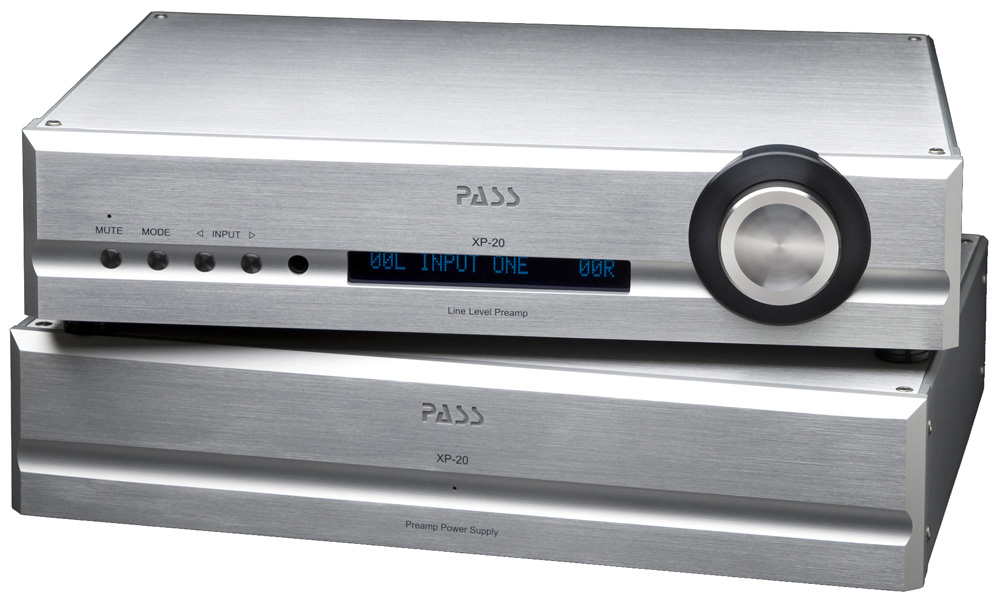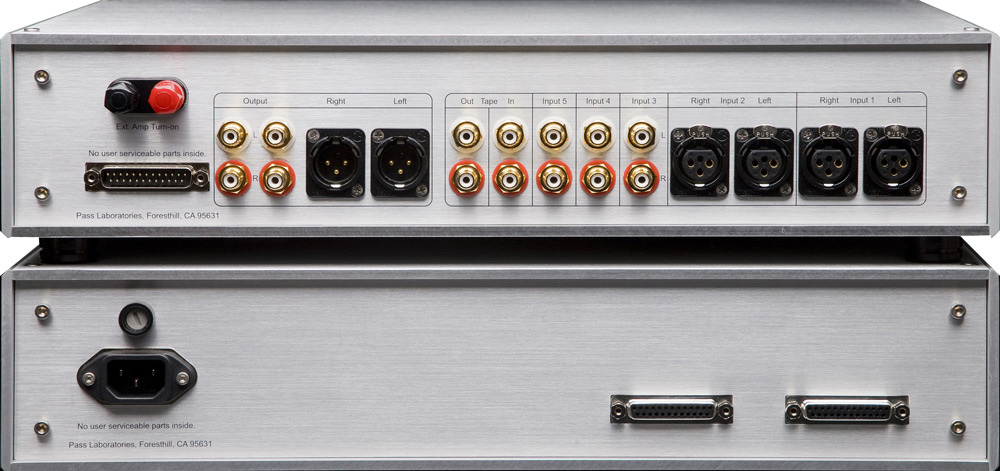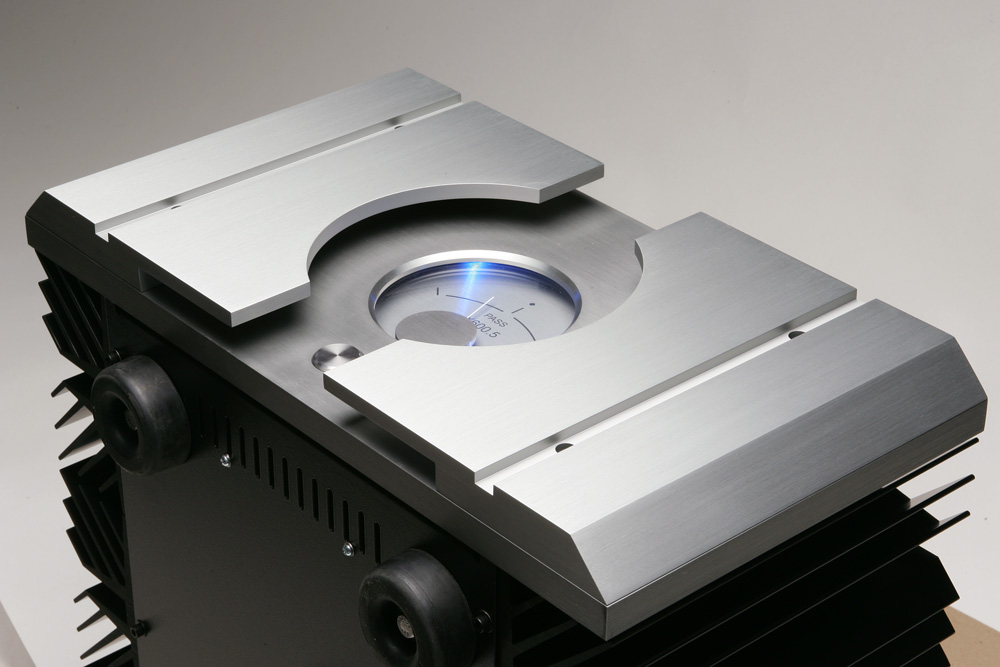On to the serious stuff – listening!
One of my favorite stock lines from the old Star Trek series was when – it seemed it occurred nearly every episode – Bones would look at James Kirk while obtaining medical readings on some stricken comrade or alien and say, “Jim, he’s dead!” Cue to a commercial.
[Commercial break: Go now to the bathroom, to get something to munch – no problem, I’ll wait.]
Resuming our discussion, as an introduction to my listening comments, I have a custom room built specifically for two channel audio, its dimensions 13’x23’x7.5’ and it is located in my basement. The room is tuned and has a thick Berber carpet with half-inch underlay. Speakers are typically set approximately four feet from the head wall and from 18-20 inches from the side walls. I typically toe in speakers to just wide of the respective ear and they sit at 12 feet from my listening chair.
I used the Pass Labs XP-20 for an extended period of time, which allowed me to hone my impressions of it. Starting with more affordable gear, an early system I set up involved the Musical Fidelity M1 CDT Transport coupled with the Eastern Electric Minimax DAC Plus, the XP-20, a pair of VAC Phi 200 tube monoblock amplifiers and the Kingsound King III electrostatic speakers, along with a mixture of Clarity Cables and Snake River Audio Cables.
The VAC Phi 200 is a romantic sounding component, not the last word in definition, but unfailingly, tonally rich. It is excellent in terms of depth and fullness of soundstage, and this was enhanced by the Pass Labs XP-20. The XP-20 in contrast to the VAC Signature Preamplifier MkII is more surgical, with analytical precision and a high degree of detail. I have taken a liking to the vocals of Marc Cohn and enjoyed the rich textures of his baritone voice on “Ghost Train”. On this piece, as well as “Perfect Love,” his voice tails off nearly to the point of imperceptibility, and can be lost quite easily if the listening level is not high. The XP-20 and X600.5 dig out these lullaby passages very well.
I had tried a more affordable amplification scheme with the Pass Labs XP-20 in the physically smaller Musical Fidelity M1 PWR Amplifier, a Class D offering. It was not as thick and tonally warm as the VAC, as would be expected. The combination did bring out more detail from the King III speakers, but at higher levels the smaller amp was not able to push the speakers without its yellow clipping warning indicator blinking. The XP-20 preamplifier should be carefully matched to Class D amps; even though they have made great advances it seems so have Class A and A/B amps, so in comparison they still tend toward a whiter, brighter sound. With very forward speakers or ones having extreme definition they could sound irritatingly edgy for listeners who want a mellow experience.
File playback and an all Pass Labs amplification scheme
Previously I had excellent results with the Pass Labs XA160.5 class A mono amps, and was expecting a thrilling time with the bigger and more powerful X600.5 class A/B model. I was not disappointed in that regard, as the macrodynamics improved markedly over the XA160.5 – as was expected. What I did not expect was to holistically enjoy the X600.5 more! I found that the differential in clarity – the XA160.5 is better – can be made up elsewhere in the system, for instance in proper selection of cables. At one point in email conversation Nelson wondered which I preferred. I will admit publicly, for the kinds of systems I build I would pick the X600.5.
The thrust, the impact and scale of the Pass Labs X600.5 cannot be matched by the smaller Musical Fidelity amp no matter what one does, as the differential is too great. I did have some difficulty getting the XP-20 and X600.5 combo to be warm enough with the King III, and it was altogether too bright and skewed to the top end with the Vapor Audio Nimbus White speakers, a surgically precise (as distinguished from clinically dead) sounding speaker with Accuton ceramic midrange drivers and a RAAL ribbon tweeter. This was the only combination of gear where the Pass Labs amplification scheme was less than commendable.
Audiophiles should not expect that even highly regarded, extremely well made gear matches perfectly with all speakers. It is rare that a component is so well balanced in every parameter that selection of the speaker is a non-issue. I listen to synthesized music as well as acoustic instrumental and jazz vocals. Many of the speakers I review do not handle them all perfectly, and frankly, neither do most amplifiers. If I play “Uphill Racer” by Patrick O’Hearn, or “Journey to Mars” by Peter White, a pre/amplifier combo can have terrific headroom, as the X600.5, but if it is too bright the music will be harsh to the ear. If I were to change the source, cables or speakers, I might not get this impression; the important thing to note is that it is not guaranteed that the combination of XP-20 and X600.5 is incapable of sounding too strident, unless you strike out for the correct style of speaker.
With the Daedalus Ulysses and Sony SS NA5-ES
Since I had plenty of time with the Pass Labs XP-20 I was able to use it with a wider variety of speakers than usual. I had come to the conclusion a while back that the Pass Labs gear would not be a personal recommendation for audiophiles seeking to drive magnetic planar speakers without true ribbon tweeters, because I have found them as a lot to be more temperamental in the treble. I still feel that is the case, despite the obvious benefits of the X600.5’s prodigious power and current capabilities. While it would drive such a speaker easily, the strong upper end of the XP-20 and X600.5 can compound unsympathetic brightness.
The most laid back of speakers in my stable of transducers is the Daedalus Audio Ulysses, which is made more in the tradition of a high efficiency design, featuring a cabinet comprised of solid woods and carrying a slight resonance to it versus the promoted deadness synthetic materials. This speaker has twin soft dome tweeters, which is ideal for the Pass Labs XP-20 and X600.5 combo. I could do nearly anything I wanted in terms of swapping cables or the source and the Pass Labs/Daedalus pairing was never edgy. Such a speaker is romantic sounding versus surgical sounding. I suggest that Pass Labs enthusiasts lean toward designs like the Daedalus in order to avoid any risk of pushing the envelope as regards having too etched or pushed forward treble.
I had a marvelous time running the Sony SS-NA5ES bookshelf speakers with the Pass Labs combo and the Silent Source “The Music Reference” cables in a noteworthy nearer-field listening system. Placed approximately 8 feet from my chair, versus 12 feet normally, the SS-NA5ES speakers were fabulously open on the top end due to their triple tweeter array, something highly unusual in a compact speaker. Where one might think that surely this would put the intensity of the treble over the top, they would be wrong as Sony utilizes, as with the Daedalus, soft dome tweeters.
A pattern emerges in these illustrations. In pairing the Pass Labs XP-20 and X600.5, if the enthusiast is concerned about high-end energy, seek a speaker known to be “laid back,” and good synergy should result. If, however, the goal is as vast and open a soundstage can be obtained, and the potential for brightness is a negligible consideration in order to achieve an intensely defined sound, then I recommend the combo with speakers having more aggressive driver sets.
To show how variable the result with the Pass Labs XP-20 preamplifier can be, I made a change of only one component, swapping in the Wells Audio Innamorata solid-state stereo amplifier in place of the X600.5 monos and the music became voluptuous, deep and with the tonality of a tubed system. The Innamorata is the closest I have found to a “tube-like” solid-state amplifier, but sacrifices not much when it comes to openness and precision. As I said, the Nimbus White speakers are sensationally revealing, and the warmer amplifier was a better match.
Here, easily I could hear the glorious crown of Pass Labs design, the unfettered openness of the midrange, a blooming of the center image to touch the edges of the left and right speakers themselves, creating panorama, not a convergence of two discrete channels. Likewise, the sense of ease increased to give the impression that singers were not trying in earnest, but were comfortably expressing themselves. To my ear when there is too much brightness in the system, female vocals remind me of a younger, immature artist, but when the extra high end energy is chased away her voice is transformed closer to a sound in the prime of her career, a bit heavier but accomplished and silkier.
A general conclusion might be drawn here. If using the XP-20 with speakers that you would consider highly revealing, then care should be taken to select an amp with characteristics of deeper, warmer tonality and not extreme definition at the cost of richness.
How important is a gargantuan soundstage to you?
It seems now that “fast exercise” and fast recovery is the real secret to getting the most out of workouts. It must be true; otherwise it might be called a fad. We supposedly derive the most benefit from bursts of frenetically paced effort for 20 seconds, followed by a brief rest; repeat several times and rinse for a fresher, cleaner you! I have begun to incorporate a variation of this routine in my workout a couple days each week. I figure I will keep at it until the next article comes along suggesting we don’t get enough endurance and recommends an entirely different approach.
Like determining whether your workout will be short bursts, long runs, or just pushing around some weights, audiophiles have to determine what system characteristics they are working toward when they hear music from their rig. Is the super-intense high definition thrill the goal, or the lingering mellow soothing nature of the experience, or a super-beefcake bass line? You have to set up your system differently in each case to achieve the goal you are after.
Audiophiles who become quite serious in the hobby determine their “must have” characteristics which will be most pleasing to them. For some tonality trumps all, while others demand extreme definition. Others pay critical attention to the soundstage and want the musicians located a specific distance from their listening chair, the size of the performance stage of a specific size, and the performers scaled to their liking. Also important can be the microdynamics which yield clues to the size of the venue, whether it be a hall-like environment such as a church or theater, or a cozier environ such as a studio.
The Pass Labs gear is ideal for those listeners who are searching for enormous soundstage and a sense of vast openness. The amps are neutral to my ear, and would not necessarily be the best choice for persons seeking a warm fuzzy moment with the music. Rather, they unflinchingly portray a vitality fit for live recordings, and along with that vitality a space-filling width and depth. The Pass Labs components yield as large a soundstage as any amplification products I have heard, offering enormous headroom. These amps will never run out of oomph; even the tougher-to-drive electrostatic speakers sound effortless when played by the X600.5 at higher listening levels. In contrast to the pure Class A XA160.5, the X600.5 does not as quickly hit a wall in terms of the demand to play the Kingsound King III electrostatic speakers at higher levels. This is one reason I have to give the nod to the X600.5, but if I were only running speakers on the higher efficiency side of systems then I might prefer the XA160.5 instead.
Audiophiles speak of sound beyond the walls, but the truth is components vary widely in how well they can produce a sense of the walls-pushed-out, or an endlessly deep acoustic space. One of the Usher Audio speaker samplers I have contains a track with ferocious Koto drums, which reverberate extensively. The Pass Labs XP-20 preamplifier does not limit the extent to which the sound waves created by the drum race toward the horizon. The drums themselves are rendered with an appropriate thud of the mallet, but more importantly an accompanying inflection of the drum skin and settling. With a lesser preamp there is only the sound of the drum, but with the XP-20 I heard what sounded like a return of the primary wave launch as it reflected off the recording venue’s walls! That is exceptional spatial definition and openness.
Healthy habits
An ounce of prevention is worth a pound of cure, and when it comes to system setup reliance upon quality craftsmanship and sound design principles, which are well executed, is worth a lot of days and money spent searching for a fix to a poor sounding system. The person who is correct for a Pass Labs product is one who knows what a seasoned sound is like, who is not interested in the merry-go-round of equipment pursued in the hope of obtaining a perfect system. The XP-20 and X600.5 are the kind of components which fit the buying pattern of “once and done.” They bring an intensely pleasurable enormous feel to any system and will always be amenable to relaxed and romantic sounding speakers. To give the reader a sense of what brands I have used which I would consider preferable, consider Wilson Benesch, Chapman Audio, Wharfedale, Tannoy, Salk Sound, Vandersteen, Sony’s NA series, and the aforementioned Daedalus.
Further, a Pass Labs device is one which the owner can know with a high degree of certainty that it will likely not wear out for decades, the kind of component having medical equipment durability. Consequently, the XP-20 and X600.5 get this reviewer’s healthy endorsement!
Associated Components:
Source: Macintosh Mac Mini; Sonos Digital Music System; Musical Fidelity M1CDT Transport Playback Software: Amarra NAS: Buffalo Linkstation 500G DAC: BMC PureDAC; Eastern Electric Minimax DAC Plus with Burson and Dexa NewClassD Discrete Opamp Upgrade; Musical Fidelity V90-DAC Preamp: VAC Renaissance Signature Preamplifier MkII; Pass Labs XP-20; Cambridge Audio 840E Amps: VAC Phi 200; Pass Labs X600.5 Monos; Musical Fidelity M1PWR (two units bridged to Mono) Integrated: Pathos Classic One MkIII stereo tube hybrid (two units bridged to mono); Peachtree Audio Nova Speakers: Kings Audio Kingsound King III; Legacy Audio DSW Clarity Edition; Kings Audio King Tower omnidirectional; Daedalus Audio Ulysses used in Landscape orientation; Vapor Audio Nimbus White Subwoofers: Legacy Audio XTREME HD (2) IC’s: Clarity Cable Organic RCA/XLR; Tara Labs RSC Air1 series 2; Wireworld Equinox; Wireworld Silver Eclipse; Wireworld Platinum Eclipse; Snake River Audio Signature Series Interconnects; Silent Source “The Music Reference” Speaker Cables: Clarity Cable Organic Speaker; Tara Labs RSC Air1; Wireworld Equinox 5; Wireworld Silver Eclipse; Snake River Audio Signature Series Speaker Cables; Silent Source “The Music Reference” Digital Cables: Clarity Cable Organic Digital; Tara Labs RSC Air 75; Wire World Startlight 6; Wireworld Gold Starlight 5, Wireworld Gold Starlight 6; Snake River Audio Boomslang; Silent Source “The Music Reference” Power Cables: Clarity Cable Vortex; MIT Oracle ZIII; Tara Labs RSC Air; Xindak PF-Gold; Wireworld Stratus 5, Electra 5 and Silver Electra; Snake River Audio Signature Series; Silent Source “The Music Reference” Power Conditioning: Wireworld Matrix Power Cord Extender; Tara Labs ISM Power Screen; Tice Audio Solo
- ← Previous page
- (Page 2 of 2)




Superb honest review. Doug Schroeder tells you something that I concur with about the character of these beautiful audio pieces. Not your standard review (like in the last 25 years) that everthing is great and the successors are even greater, but he tells you honestly what’s on his mind.
Much kudos for you Doug